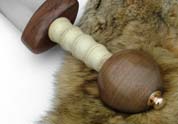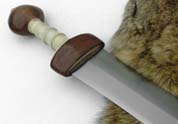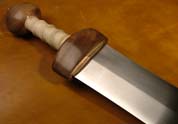|
|

The Aquilifer
Limited
Edition Roman Gladius
(Fulham style)
The Roman Legions were
renowned for their brutal, efficient use of the short sword and over the
centuries the style of short sword changed as tactics changed or were
refined. Beginning with the "gladius Hispaniensis" (based on
a Celt-Iberian leaf-bladed short sword), over time the sword became shorter
and broader (the Mainz and Fulham patterns) and culminated in the "Pompeii"
style stabbing sword.
The Fulham pattern gladius is of the same early period as the Mainz style
-- it has been theorized that they are actually the same basic pattern
and represent only a slight variation of the basic leaf-blade pattern,
possibly due to differing regional or manufacturing styles.
Like the Mainz gladius, the Fulham has a long point and the blade is
"waisted," but in the case of the Fulham it is not as severe
as in the Mainz.
The Greek historian Dionysus
of Halicarnassus (contemporary to Emperor Augustus 63 BC-14 AD) describes
Roman tactics with swords against the Gauls in the 4th C BC. Dionysus
describes events that is some 300 years earlier than his own times, but
we might perhaps presume that the fighting techniques he describes were
not anachronistic to his own period. It is during the late 1st C BC that
the Mainz type Gladius developed from the longer Gladius Hispaniensis
that the Romans adopted during the Punic wars. Both the longer Gladius
Hispanienis and the Mainz type gladius were effective cutting swords,
even if thrusting was a favoured tactic in close formations.
...Holding their sword straight out, they would strike
their opponents in the groin, pierce their sides, and drive their blows
through their breasts into their vitals. And if they saw any of them keeping
these parts of the body protected, they would cut the tendons of their
knees or ankles and topple them to the ground roaring and biting their
shields and uttering cries resembling the howling of wild beasts...
We can see how the cut was accepted as a perfectly viable method to dispatch
an opponent, if the thrust did not prove effective. Vegetius describes
how recruits are trained using wooden swords against stout posts, as though
attacking different parts of the opponents body. A crippling cut against
the backside of the leg was included in these techniques.
The guard and pommel are hand-crafted of walnut, the grip turned from
holly, and the inset guard plate and pommel nut are of bronze.
A Limited Edition Hand Crafted Collectible Sword
This sword is offered in a limited edition of only 500 collectible swords
worldwide.
Name That Sword Contest Winner:
Matt Molloy
"The Aquilifer was the ancient equivalent of todays high ranking Non Commissioned
Officers, such as a Sargent Major. These men would have seen countless
engagements and would be armed in better fashion than their lower ranking
brethren."
Specifications
Overall length: 28.125" (71.44 cm)
Blade length: 20.375" (51.75 cm)
Blade width: 2.375" (6 cm)
CoP: n/a
CoB: 4" (10.16 cm)
Weight: 1 lb 8.2 oz (685 grams)
.
The Aquilifer (Fulham
Gladius)... $770
Order
now before this limited
edition collectible sword runs out!.
|







